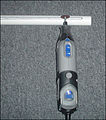Algae scrubber
Methods
[edit | edit source]Construction of the waterfall version
[edit | edit source]Pipe: A basic algae scrubber starts out with a ¾" (1.88 cm) PVC pipe, with a 1/8" (3mm) slot cut along the length of it (the slot is only on the bottom side; it does not go through to the top side). The pipe is marked with a marker, and cut with a motorized cutting tool.
Screen: A piece of "plastic canvas" (otherwise known as "knitting screen") is purchased at sewing or crafts stores, or online. It is roughed up with a "hole saw" from a hardware store; the hole saw is dragged by hand, back and forth across the screen.
Lights: The lights are attached on both sides, and pointed to the middle of the screen. The bulbs are about 4" (10 cm) from the screen. Simple CFL (compact fluorescent) bulbs with clip-on sockets and large reflectors work well. The bulbs that say "warm" or "soft" usually work the best. The bulbs are put on a timer, so that they are on for 18 hours a day, and off for 6 hours.
Size
[edit | edit source]Previous scrubbers were sized according to the number of gallons or liters of water; scrubbers are now sized according to feeding. Nutrients "in" (feeding) must equal nutrients "out" (scrubber growth), no matter how many gallons or liters there are. Thus:
An example vertical upflow or waterfall screen size is 3×4 inches = 12 square inches of screen (7.5×10 cm = 75 cm2) with a total of 12 real watts (not equivalent) of fluorescent light for 18 hours a day. If all 12 watts are on one side, it is a 1-sided screen. If 6 watts are on each side, it is a 2-sided screen, but the total is still 12 watts for 18 hours a day. This screen size and wattage should be able to handle the following amounts of daily feeding:
- 1 frozen cube per day (2-sided screen), or
- 1/2 frozen cube per day (1-sided screen), or
- 10 pinches of flake food per day (2-sided screen), or
- 5 pinches of flake food per day (1-sided screen), or
- 10 square inches (60 sq cm) of nori per day (2-sided screen), or
- 5 square inches (30 sq cm) of nori per day (1-sided screen), or
- 0.1 dry ounce (2.8 grams) of pellet food per day (2-sided screen), or
- 0.05 dry ounce (1.4 grams) of pellet food per day (1-sided screen)
- High-wattage technique
- Double the wattage, and cut the hours in half (to 9 per day). This will get brown screens to grow green much faster. Thus the example above would be 12 watts on each side, for a total of 24 watts, but for only 9 hours per day. If growth starts to turn yellow, then increase the flow, or add iron, or reduce the number of hours. And since the bulbs are operating for 9 hours instead of 18, they will last 6 months instead of 3 months.
- Horizontal screens
- Multiply the screen size by 4, and the wattage by 1 1/2. Flow is 24 hours, and is at least 35 gph per inch of width of screen (60 lph per cm), even if one sided or horizontal.
- Floating surface scrubbers
- Screen size is the size of the box (Length×Width), and is 2-sided because the ribbons grow in 3D.
- LEDs
- Use half the wattage as above. 660 nm (red) is best. You can mix in a little 450 nm (blue) if you want.
Cleaning
[edit | edit source]Generally, and except for specific continuous-filtering or continuous-cultivating versions, algae scrubbers require the algae to be removed ("harvested") periodically from the scrubber. This removal of algae has the effect of removing undesired nutrients from the water because the algae used the nutrients in order to grow. The algae is generally removed either: Every 7 to 21 days, or When it is black, or When it fills up the scrubber, or When it starts letting go, or When nutrients start to rise in the water. For waterfall versions, the screen is removed from the pipe and cleaned in a sink with running water. The pipe is removed also, and the slot is cleaned with a toothbrush, to remove any algae that have grown up into it. After the algae are removed, the screen and pipe are put back in the scrubber. For upflow versions, the cleaning method depends on the type: Glass-attached version: The magnet portion outside the glass is removed, and the inside portion is lifted out of the water. If the growth is thick green hair algae, then it is just removed by hand. If the growth is thin green hair (as occurs in freshwater) or dark slime, then the inside unit is taken to the sink and cleaned with a toothbrush. After cleaning, the inside and outside parts are put back into place on the glass. Floating-surface version: If the growth is thick green hair algae then it is just removed by hand by lifting the LED lid up and pulling the growth out. If the growth is thin green hair or dark slime, then the floating portion is taken to the sink and cleaned with a toothbrush. Drop-in version: The entire unit is lifted out of the water, and the lid is removed. If the growth is thick green hair algae then it is just removed by hand. If the growth is thin green hair or dark slime, then the whole unit is taken to the sink and cleaned with a toothbrush. If the screen is not cleaned like this periodically, the algae will get too thick and block light and flow from reaching the "roots" of the algae, and these areas will die and let go, putting nutrients back into the water.





